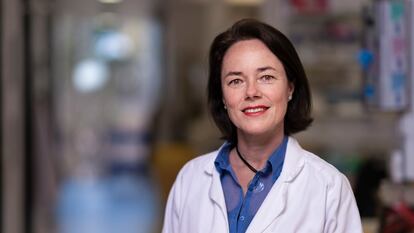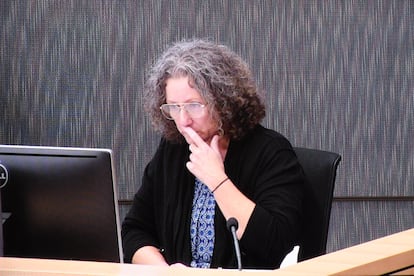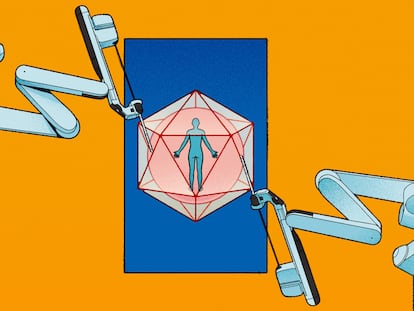Why scientists are trying to free Australia’s ‘worst female serial killer’
Carola García Vinuesa’s work is the key to the case of Kathleen Folbigg, convicted of the deaths of her four children in what could prove to be a historic miscarriage of justice

Carola García Vinuesa, 52, was a respected figure in Australia. Head of the immunology department at the Australian National University, she was also director of the Center for Personalized Immunology and her team had pioneered the sequencing of the human genome in the country. International lectures on genetic immunology were a frequent feature on her agenda, and a few awards lined the shelves at her home in Canberra, where she lived with her two daughters.
Kathleen Folbigg, 54, meanwhile, had been dubbed Australia’s “worst female serial killer” by the tabloids, turning her into the most hated woman in the country in 2003, the year she was sent down for 40 years for the murder of her four children. The lives of these two women could not have been more different and there was nothing to suggest their paths would cross. Until one morning in August 2018, when Vinuesa’s phone started ringing.
“It was my former student, David Wallace,” she tells EL PAÍS, adding that, although a brilliant researcher, Wallace had ended up in law. But this wasn’t a catch-up call. Wallace wanted Vinuesa’s opinion on a case he was working on; something didn’t quite add up. “Are you sitting down?” he asked. And then, he began.
Kathleen Briton met Craig Folbigg at the age of 17 in a nightclub. They fell in love, got married and decided to start a family. Their first son, Caleb, was born in February 1989. According to court records, Kathleen claimed to feel “complete, with a husband, a home and a baby.” But that feeling would be short-lived. One night, Kathleen got up to go to the bathroom and checked on the baby. He wasn’t breathing. “My baby! There’s something wrong with my baby!” she screamed. Her husband hurried into the room and noticed the child’s body was still warm. He tried to revive him and told Kathleen to call an ambulance. The doctors could do nothing to save him, and recorded that he had suffered sudden infant death syndrome (SIDS), a condition about which little was known at the time. Caleb was just 19 days old.
In 1990, the couple had their second son, who they named Patrick. Tests showed him to be a healthy boy, but at four months, he suffered a seizure in similar circumstances, followed by epilepsy and blindness. Shortly thereafter, while in Kathleen Folbigg’s care, Patrick suffered subsequent seizures and died.
The Folbiggs determined to make a fresh start in a new city where they had a daughter, Sarah. This time, they moved the crib into their bedroom so they could keep an eye on her while she slept. But in the middle of the night, on August 30, 1993, Kathleen turned on the light and found her baby girl lying blue and motionless. She was pronounced dead at 10 months. The cause, once again: SIDS.
Craig didn’t want more children, but Kathleen insisted, and a few years later the couple had a fourth daughter, Laura. Doctors sent the little girl home with a heart monitor that transmitted data directly to the hospital. Laura made it through her first year of life with no problems. But at 18 months she died. And all the alarms went off. The doctor who performed the autopsy, Dr. Allan Cala, indicated that she had signs of myocarditis, but stated in his report that this was not life-threatening. A detective was assigned to the case that same day.
The Folbiggs’ marriage couldn’t withstand the strain and they separated a few months later. It was then that Craig discovered an old diary Kathleen had kept with entries that prompted him to go to the police. Writing on January 28, 1998, Kathleen said that Sarah had left “with a little help.”

The trial was quick and bizarre. There was no evidence against Kathleen beyond a few ambiguous sentences, like the one above, in her diaries. Instead, the prosecution relied on the extraordinariness of the case. “There has never, ever been in the history of medicine any case like this,” the prosecutor said in his closing argument.
Carola García Vinuesa listened attentively to Wallace as he went through the details. A month earlier, she had been contacted about a case in Macedonia in which three siblings had died. The fourth sibling died days after Vinuesa found the genetic malformation that had caused their demise.
Wallace asked his former professor if she could look into the possibility that a similar genetic malformation was responsible for the deaths in the Folbigg case. “It seemed plausible because things had come a long way from 2003, which is when the trial took place, to 2018, which is when I got the call,” she says. Vinuesa hung up the phone and began to investigate.
Genetic research and the judicial investigation
SIDS began to be recognized medically in 1969 as a sort of forensic catch-all to classify deaths that couldn’t be otherwise explained. However, in the last two decades, the mutations that could predispose infants to SIDS have been pinpointed. Up to 35% of sudden deaths can be explained by genetic factors. Two of Folbigg children’s deaths had been blamed on SIDS. Perhaps technological advances could provide more clues as to exactly what happened to them.
Prepared to find out, Vinuesa called her colleague, geneticist Todor Arsov and together they made a list of all the genes that could cause sudden death. Then they started sequencing Kathleen Folbigg’s genome, revealing that she had a mutation in the CALM2 gene that could cause SIDS. It was an important breakthrough.
A detailed investigation was launched with two teams of immunologist-geneticists. Vinuesa’s team found the same mutation in the Folbiggs’ two daughters. They concluded that it was probably pathogenic. “This means that there is more than a 99% chance that it will cause heart disease leading to a fatal outcome,” Dr. Arsov tells EL PAÍS. “As evidence, I think this finding would carry the same weight as having a confession or an eyewitness to a crime.” But the prosecution team, led by Dr. Michael Buckley, didn’t see it that way. He said it was “a variant of uncertain significance” and pointed to the lack of a family history regarding the condition.
Concerned about Buckley’s position, Dr. Vinuesa sought outside support to confirm her findings. “I wrote to the most famous cardiologist-geneticists in the world,” she recalls. One of them was Peter Schwartz from the Auxological Institute in Milan. He wrote back saying he had just studied a similar case. Schwartz had been analyzing the causes of sudden death for more than 50 years. He had created a database of information on 74 families who had suffered syncopes related to mutations in the CALM genes. And he had this to say about the Folbigg case: “Look, I can’t say for sure that the mother is innocent. But if a child with a genetic mutation like this dies, it’s logical to think, natural causes. It’s like if you have a dead person with a gunshot to the head. He may have died of a heart attack and then someone shot him. But the normal thing is to think that he died in a shooting,” he explains.
Mutations in the CALM2 gene alone would explain the deaths of two of the four Folbigg children. Regarding Caleb and Patrick, they were found to carry two rare variants of the BSN gene, which causes lethal epilepsy in mice. The finding was inconclusive and further testing was needed. But it was not so much a matter of establishing an irrefutable cause of death for the four children, but of establishing whether there was reasonable doubt regarding Folbigg’s guilt. It was determined at the time of the trial that there was not, but it is precisely the passage of time that is important in this story.
Kathleen Folbigg became the most hated woman in Australia in the early 2000s, an era in the field of child protection when British pediatrician Roy Meadow’s voice was resonating in child death cases. Meadow came up with this damning maxim: “One [sudden death] is a tragedy, two is suspicious and three is murder unless there is proof to the contrary.” It became known as Meadow’s law, and applied in several infanticide trials in the United Kingdom; until science picked holes in it. A genetic study of the two children of lawyer Sally Clark, sentenced to life imprisonment, opened up the possibility that they had died of natural causes. The British courts freed Clark and reviewed the convictions in similar cases over the previous 10 years, leading to the release of three more women. Meadow was discredited and struck off the medical register, though he was reinstated a year later. The British courts ruled that, in the future, no prosecutions would be brought if medical experts failed to reach a consensus, unless there was other convincing evidence.
Meadow’s law was not explicitly cited in the Folbigg case, but it cast a shadow over the entire trial. Prosecutors went so far as to argue that the death of four babies in the same family was as likely “as pigs flying,” without backing up the parallel with any evidence. But that was 2003. Now, with Meadow’s law discredited and the genetic mutations established, Folbigg had a chance.
The verdict
In 2019, the Australian judges refused to release Folbigg. They dismissed the research carried out by Vinuesa’s team and gave greater weight to the prosecution’s arguments. “They had nothing,” says Vinuesa. “There was the diary and then these geneticists and the cardiologist, Jonathon Skinner, who didn’t want to admit they were wrong. They didn’t want to back down out of pride, because of their egos.”
Schwartz agrees, and points to Skinner’s lack of training. He compares the statements made by Skinner before the judge with data from his own research. “For example, it was said that the mutation should have given rise to de novo mutations in children. That is not true,” Schwartz points out. “It was said that the children had died in their sleep and not while playing sports and that this does not usually happen. Not true; 20% of sudden deaths happen during sleep. It was pointed out as strange that these were the first attacks suffered by these children. And it is not true: 80% of deaths of this type occur with the first episode. A number of erroneous statements were made and there is no possible justification. They could have read our work, or called us. We had the answers.”
In March 2021, 90 scientists and medical experts from around the world handed the governor of New South Wales a petition requesting Folbigg’s pardon and release. Among the signatories were two Nobel laureates and numerous heavyweights in the world of medicine.
Folbigg remained in prison, but the social climate had changed: she was no longer the most hated woman in Australia and society no longer unanimously condemned her. Some began to see her case not as one of the country’s worst serial killer, but as the biggest miscarriage of justice in Australia’s history. The climate also changed in prison. Having been transferred for her own protection from other inmates, Folbigg began to receive gestures of support, as she told Carola García Vinuesa when she went to visit her.
“It was a bittersweet moment,” Vinuesa recalls. It was also a farewell. After years in Australia, Vinuesa was moving to the United Kingdom. Before doing so, she wanted to chat with the person she had been studying genetically over the last few years. The journey had begun out of curiosity, continued out of conviction – even, she suspected, out of obsession. It was not just a genetic study. Vinuesa came to see that the Folbigg case reflected the way science is presented in a trial. It showed how circumstantial evidence carries more weight than scientific research. And it also brought to light the number of women who had been judged and stigmatized on no medical grounds whatsoever. The Folbigg case transcended Folbigg herself.
But that was difficult to say in front of Kathleen Folbigg because it has also been her personal struggle for justice. Vinuesa was leaving Australia, but that didn’t mean she was abandoning Kathleen. The immunologist remains in contact with Folbigg’s legal team and is closely following attempts to reopen the case. It has been 19 years since Kathleen Folbigg was convicted, but Vinuesa is hopeful. “In the end, we are talking about science and the science is irrefutable,” she says. “It’s black and white.”
Tu suscripción se está usando en otro dispositivo
¿Quieres añadir otro usuario a tu suscripción?
Si continúas leyendo en este dispositivo, no se podrá leer en el otro.
FlechaTu suscripción se está usando en otro dispositivo y solo puedes acceder a EL PAÍS desde un dispositivo a la vez.
Si quieres compartir tu cuenta, cambia tu suscripción a la modalidad Premium, así podrás añadir otro usuario. Cada uno accederá con su propia cuenta de email, lo que os permitirá personalizar vuestra experiencia en EL PAÍS.
¿Tienes una suscripción de empresa? Accede aquí para contratar más cuentas.
En el caso de no saber quién está usando tu cuenta, te recomendamos cambiar tu contraseña aquí.
Si decides continuar compartiendo tu cuenta, este mensaje se mostrará en tu dispositivo y en el de la otra persona que está usando tu cuenta de forma indefinida, afectando a tu experiencia de lectura. Puedes consultar aquí los términos y condiciones de la suscripción digital.
More information
Últimas noticias
The complicated life of Francesca Albanese: A rising figure in Italy but barred from every bank by Trump’s sanctions
Half of Scotland is in the hands of 420 property owners
Reinhard Genzel, Nobel laureate in physics: ‘One-minute videos will never give you the truth’
Pinochet’s victims grapple with José Antonio Kast’s rise in Chile
Most viewed
- Pablo Escobar’s hippos: A serious environmental problem, 40 years on
- Reinhard Genzel, Nobel laureate in physics: ‘One-minute videos will never give you the truth’
- Why we lost the habit of sleeping in two segments and how that changed our sense of time
- Charles Dubouloz, mountaineering star, retires at 36 with a farewell tour inspired by Walter Bonatti
- The Florida Keys tourist paradise is besieged by immigration agents: ‘We’ve never seen anything like this’











































